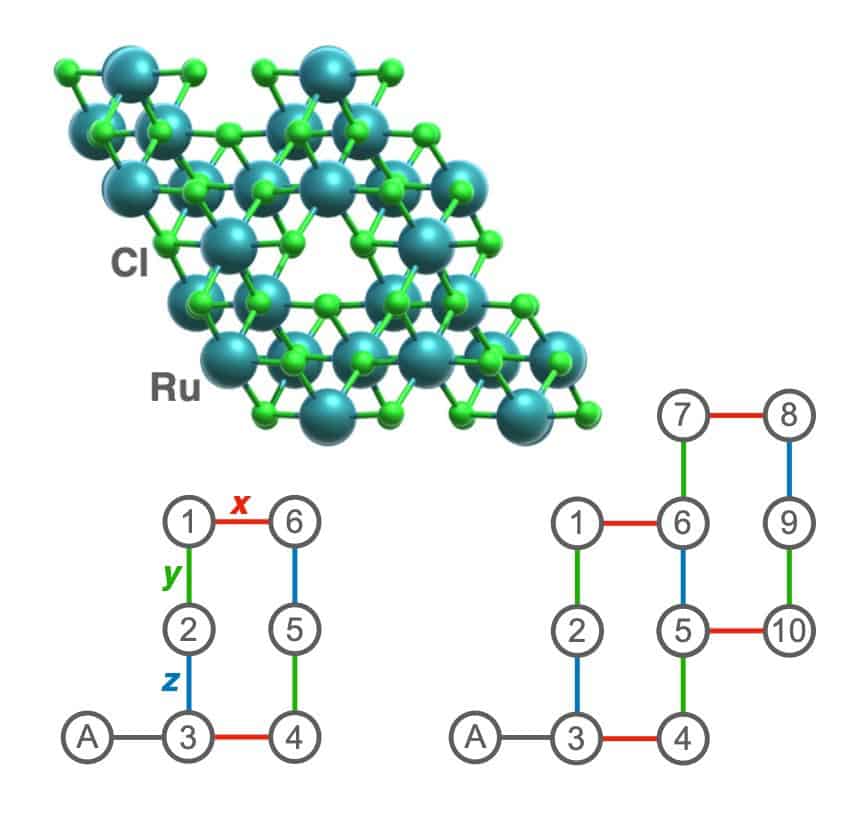Quantum processors still struggle to simulate complex molecules
10 Feb 2023 Ieva Čepaitė
Possible spin liquid: Lattice structure of ⍺-ruthenium trichloride (top) and encodings of its spin-model topology into qubits (bottom). (Courtesy: Garnet Chan)
The quantum nature of complex molecules and materials makes them very challenging to simulate. To learn about their properties, a classical computer must store and process huge amounts of data. Quantum computers bypass this by manipulating quantum systems directly, which in theory gives them an advantage over their classical counterparts. In practice, however, today’s quantum devices are sensitive to noise due to interactions with their environment, greatly diminishing their potential advantages.
In recent years, several teams (including Google in 2019 and researchers at the University of Science and Technology of China in 2020) have claimed that their quantum devices have “quantum advantage” over classical ones. However, the design of such experiments has largely played to the strengths of the quantum technologies in question rather than focusing on practical applications. This has made it difficult to assess how quantum devices would fare when applied to problems that are considered “useful” and intractable to classical computers, such as the simulation of complex quantum chemistry.
A team led by Garnet Chan of the California Institute of Technology, US, has now provided some insight into this question by performing simulations of two quantum chemistry problems on Google’s 53-qubit Weber quantum processor. The first simulation centred on a cluster of eight atoms inside the enzyme nitrogenase. This enzyme is an important component in a chemical process called nitrogen fixation, and a better understanding of its chemical properties could revolutionize fertilizer manufacturing. The second simulation focused on α-ruthenium trichloride, a material that may exist in an exotic quantum phase known as a “spin liquid” at low temperatures. Such materials are not well-understood and could have applications in data storage, topological quantum computation and even high-temperature superconductivity.
A long way to go
To calculate properties of interest in complex molecules and materials (such as their electronic energy states or low-energy excitations), physicists begin by mapping the electron spins of the atoms to qubits in the quantum device. The interactions between the electrons in the original chemical systems can then be captured by applying quantum “logic gates” in a certain order to the qubits. Finally, researchers extract information about the system by measuring the qubits and analysing the measurement outcomes. The more logic gates that need to be applied to capture the behaviour of the electron spins, the more noise and errors accumulate during the computation, leading to less reliable results. Nitrogen fixer: Molecular structure of clusters of iron and sulphate found inside the nitrogenase enzyme (left) and their encodings into qubits (right), where lines indicate qubit connectivity and “A” is a helper qubit in the computation. (Courtesy: Garnet Chan)
Nitrogen fixer: Molecular structure of clusters of iron and sulphate found inside the nitrogenase enzyme (left) and their encodings into qubits (right), where lines indicate qubit connectivity and “A” is a helper qubit in the computation. (Courtesy: Garnet Chan)
 Nitrogen fixer: Molecular structure of clusters of iron and sulphate found inside the nitrogenase enzyme (left) and their encodings into qubits (right), where lines indicate qubit connectivity and “A” is a helper qubit in the computation. (Courtesy: Garnet Chan)
Nitrogen fixer: Molecular structure of clusters of iron and sulphate found inside the nitrogenase enzyme (left) and their encodings into qubits (right), where lines indicate qubit connectivity and “A” is a helper qubit in the computation. (Courtesy: Garnet Chan)In the new work, which is described in PRX Quantum, Chan and colleagues found that as their computations grew larger and required more gates, noise in the system quickly overwhelmed the useful information they wanted to extract. For example, their experiments showed that while simulations of a crystalline lattice of α-ruthenium trichloride containing six atoms provided several meaningful results, this was no longer true when the size of the problem increased to 10 atoms or more.
Similarly, they could predict energy spectra for an 8-atom cluster found in nitrogenase reasonably well, but only after applying a myriad of post-processing techniques on the measurement data. What is more, the quantum experiments treated only simplified models of these systems, where classical computers are still able to provide exact estimates. This implies that quantum advantage is not yet a reality for such simulations.
Choosing the right problems
The results weren’t all bad news for quantum simulators, however. The researchers note that the capabilities of the quantum device depend dramatically on the type of problem being investigated, and for this series of experiments, they deliberately avoided choosing problems that catered to the Weber architecture. Instead, they chose to focus on how interesting the results of the simulation would be to the wider scientific community. When they modified their simulation parameters to better suit the quantum processor, they cut their computational resources in half, and therefore generated more meaningful results.READ MORE

Ultimately, though, the results show that quantum devices that can replace classical supercomputers are still some ways off. “These overly simplified models of realistic chemical systems and materials that we chose to simulate in our work can be trivially simulated on a classical computer or even a personal laptop,” says Ruslan Tazhigulov, who led the study as a postdoc in Chan’s team and is now a data scientist at the pharmaceuticals firm EQRx. “After applying various error mitigation techniques, we demonstrate that there is still a long way to go for quantum devices to become practical tools in solving complex quantum chemistry problems.”
Want to read more?Register to unlock all the content on the site
E-MAIL ADDRESS
Register

Ieva Čepaitė is a PhD student contributor to Physics World. Ieva studies quantum physics at the University of Strathclyde. Find out more about our student contributor networks
from physicsworld.com 13/2/2023

Δεν υπάρχουν σχόλια:
Δημοσίευση σχολίου